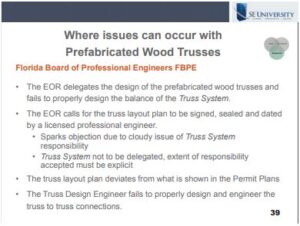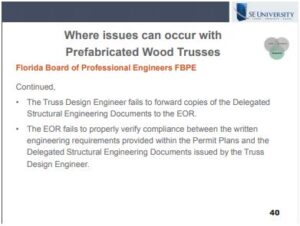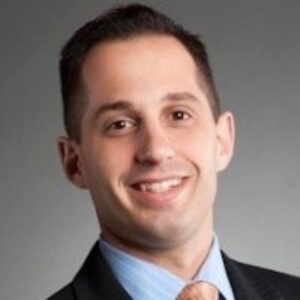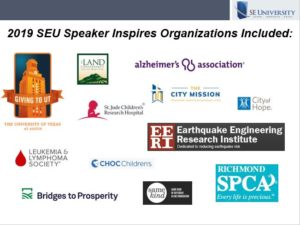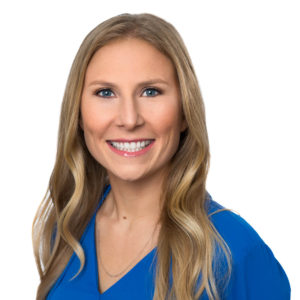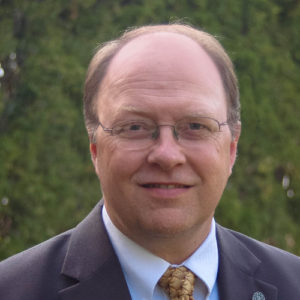28 Feb / 2020
Avoiding Common Issues with Deferred Submittals
Building design is becoming more integrated in the modern age. More and more structural designs include proprietary products and delegated design professionals in order to speed up construction schedules. How does this affect the Engineer of Record?
During the January 2020 SE University session Delegated Design: Addressing Potential Risks with Proper Project Management, Doug Allen, PE, from Simpson Strong-Tie, reviewed the complications that arise with delegated design and deferred submittals. He also covered potential ethical, monetary, and legal consequences of poor project management.
Doug offered a helpful outline, as shown below, of common issues that have been found on projects with prefabricated wood trusses. Although the list is specifically addressed for projects with prefabricated wood trusses, many of the communication issues displayed can be extrapolated to other delegated design jobs as well.
On projects where part of the design is delegated, it is critically important for the EOR to clearly outline the extent of the design and complete design and performance criteria for the delegated designer. While the EOR retains responsibility for the structural system as a whole, the delegated designer must comply with the requirements within the structural documents, including required submittals. Many times, these deferred submittals create opportunities for miscommunication.
Typically, the most common pitfalls with deferred submittals include omissions or non-compliance with the structural documents, failure to provide submittals to the EOR for review, or failure of the EOR to properly review the submittals for compliance. When discrepancies are noted, some re-design may be necessary to ensure code compliance. Then, revised structural documents should be resubmitted to all involved parties. Each layer of back and forth communication leaves room for error during this time-critical design process, and any lack of oversight could prove costly, or even deadly. Doug reviewed several instances of structural collapse due to improper communications during the submittal process.
When embarking on a project involving delegated design, project specific communication checklists can be helpful to ensure required submittals are received, reviewed, and properly responded to in a timely manner. Any final sign off from the EOR should be withheld until all required documents have been received and reviewed. As with any project, communication is key; However, with delegated design, it can be critical for the structural integrity of the project.
24 Jan / 2020
“SEU Speaker Inspires” Organization of the Month: Same Kind of Different as Me Foundation
In December 2019, SE University welcomed Anthony Fasano, PE, from Engineering Management Institute, to present Developing Effective Communication Skills for Structural Engineers. Anthony designated Same Kind of Different as Me Foundation (https://www.samekindofdifferentasmefoundation.org/) for our SEU Speaker Inspires donation for the month.
Anthony shared, “What stood out to me about this organization is that around this time during the holidays, we should be thankful for the things that we have like our families and the homes we share with them. This organization helps people find homes.”
Same Kind of Different as Me Foundations aims to help the homeless through funding immediate needs for homeless shelters and helping those who struggle with homelessness find a shelter.
Thank you, Anthony, for helping structural engineers with your SE University session, and for your designation of Same Kind of Different as Me Foundation as one of our SEU Speaker Inspires Organizations of the Month!
SE University began the SEU Speaker Inspires program in 2015 as a way to “pay it forward”, enabling our speakers to designate a charity/organization of their choice for SE University to make a donation to help improve our world.
24 Jan / 2020
Listening and Responding to Clients
The field of structural engineering is, by nature, a collaborative endeavor. Whether you work with architects, government agencies, or individual clients, good communication skills are necessary to effectively work and manage your projects. What are the biggest obstacles you face when working with co-workers, clients, or contractors? Typically, poor communication is at the heart of most frustrations and conflicts during any given project.
In the December 2019 SE University session, Anthony Fasano, PE, from the Engineering Management Institute, presented Developing Effective Communication Skills for Structural Engineers. Anthony offered strategies to improve communication between team members, ways to listen more effectively, and respond appropriately when communicating with others.
Anthony offered several tips on improving listening skills. Since listening is half of communication, it is crucial to let others be heard. Anthony noted that we often jump into a conversation when we feel we can solve the problem being discussed, however, it is more important to allow people to finish their thoughts without intrusion and to listen for silence for a full second before speaking. It can also be helpful to acknowledge the thoughts of the other person by repeating back their ideas to reinforce their importance and ensure you have understood their point of view.
Anthony also reviewed the importance of responsiveness in communicating with clients. Our clients expect answers immediately in today’s fast paced work environment. While instant replies may not be feasible, it helps to acknowledge receipt of their communication, and provide a realistic timeline for when you will be able to complete their request. This reinforces their importance as your client and doesn’t leave them wondering if the communication was received or lost. Quick responses also improve your reputation as being attentive and timely in your service. Clients may not return in the future if they feel neglected or frustrated during the project collaboration.
Communication skills can always be improved, but they must be intentionally modified, otherwise we tend to fall into our usual patterns. Listening patiently and responding to clients in a timely manner can really improve teamwork and heighten your reputation for being professional and competent.
Anthony Fasano, P.E. is a globally recognized best-selling author, speaker, host of three engineering podcasts that have been downloaded over 3 million times, and author of the bestselling book for engineers entitled Engineer Your Own Success: 7 Key Elements to Creating an Extraordinary Engineering Career (by IEEE-Wiley Press). He is the founder of The Engineering Management Institute previously known as the Engineering Career Coach, which has helped thousands of engineering professionals develop their management and leadership skills. He also is the author of the popular ASCE Careers & Leadership Blog, and host of The Structural Engineering Channel podcast.
Fasano has also co-authored a series of children’s books with his 11-year-old daughter titled Purpee the Purple Dragon. They have delivered hundreds of books to pediatric cancer centers around the world.
26 Dec / 2019
Happy Holidays from SE University
|
Happy Holidays from SE University! It’s the holiday season, and we would like to take this opportunity to thank our SE University clients and speakers for being a part of our SEU family during 2019. Because of your support, we have been able to make many charitable donations during the past year through our SEU Speaker Inspires program. Click on a speaker name below to learn more about their donation, and click on the organizations to visit their websites.
SE Solutions began the SEU Speaker Inspires program in 2015 as a way to “pay it forward”, enabling our speakers to designate a charity/organization of their choice for SE University to make a donation to help improve our world. To read more about SEU Speaker Inspires, please visit the SEU Speaker Inspires category on the SE University blog. We want to thank our speakers throughout the year who participated in this program, and we look forward to future donations in 2020. Warm wishes for a wonderful holiday season!
|
26 Dec / 2019
Wind Loads on Screen Walls and Roof Top Equipment
How does your office approach the design of roof top screen walls? They are all too common since they do well to hide roof top equipment or offer privacy on residential buildings. However, in the past, they have not been explicitly addressed in the code. Some engineers use the provisions for roof top structures and equipment, others use solid freestanding signs, and some argument could be made for using the parapet provisions.
In the November 2019 SE University session, Emily Guglielmo, SE, from Martin/Martin, presented Wind Loads on Non-Building Structures. Emily reviewed the ASCE7 wind provisions for non-building structures, but also offered some guidance on non-building structures that are not specifically addressed in ASCE7. She also provided some additional resources available to engineers to help fill in the gaps where the code may be silent on some situations.
Emily explained new language added to the commentary of ASCE7-16. As you can see in the slide below, the commentary now makes it clear that screen walls should be designed in accordance with Section 29.5.1.
Using this new guidance from the code, the design of screen walls is now more explicit, however, an obvious follow up question would be whether shielding can then be considered for equipment surrounded by a screen wall. Although each case is unique, Emily offered some guidance on this situation. Watch this short 3 minute video to hear Emily’s recommendation on the use of shielding on roof top structures.
In November 2019, SE University welcomed Emily Guglielmo, SE, from Martin/Martin, to present Wind Loads on Non-Building Structures. In 2015, Emily designated Bridges to Prosperity (https://bridgestoprosperity.org/) for our SEU Speaker Inspires donation for the month, and she has chosen to do the same in 2019.
Emily said this about her choice, “Bridges to Prosperity believes that every person has a right to safe access and has engineered innovative, scalable approaches to act on that belief. As an engineer, it’s inspiring to see other engineers using their passion for the profession to implement real change in the world.”
Thank you, Emily, for helping structural engineers with your SE University session, and for your designation of Bridges to Prosperity as one of our SEU Speaker Inspires Organizations of the Month!
SE University began the SEU Speaker Inspires program in 2015 as a way to “pay it forward”, enabling our speakers to designate a charity/organization of their choice for SE University to make a donation to help improve our world.
29 Nov / 2019
Tilt-Up Wall Anchorage
The design of wall anchorage in tilt-up walls has been influenced most by past failures during seismic events. While many failures were the result of cross-grain bending in wood roof designs, many problems were found also in steel structures, where the steel lacked the necessary ductility and overstrength required during an earthquake. How do ACI and ASCE 7 address the design of wall anchorage to ensure these past failures are not repeated?
In the July 2019 SE University session, John Lawson, PE, SE, from Cal Poly – San Luis Obispo, presented Engineering Tilt-Up: Design Provisions Born from Past Experience. John reviewed how past failures have influenced current design practices and explained the implementation of current slender wall provisions and how to classify wall elements. He also covered wall anchorage forces and how they get transferred into the diaphragm and potential issues with both steel and wood deck roofs.
John noted during the session that even in regions where wind typically governs the building design, seismic can still govern in the case of the wall anchorage design force. After noting past failures at the wall anchorage, the design force has been increased to maximum expected forces to ensure the connection can withstand the required ductility and strength required during an earthquake. Since the wall anchorage force is 3-4 times the ground acceleration, this design force can often exceed the design wind force, even though wind may control the design of the tilt-up wall panel.
John explained the process to determine the required design force for wall anchorage. Watch the following 4 minute video to hear John walk through the wall anchorage design equation, including some valuable tips for this design process.
29 Nov / 2019
“SEU Speaker Inspires” Organization of the Month: St. Jude Children’s Research Hospital
In October 2019, SE University welcomed Bruce Brothersen, PE, SE, from Vulcraft, and Walter Worthley, PE, SE, from Valley Joist, to present Retrofitting of Existing Buildings with Steel Joists. Walt designated St. Jude Children’s Research Hospital (https://www.stjude.org/) for one of the SEU Speaker Inspires donations for this month.
Walt shared: “The St. Jude Children’s Research Hospital continues to provide exceptional care for children with cancer. Their work in helping patients and families deal with this disease, as well as help to find cures, continues to be an inspiration to every life they touch.”
Thank you, Walt, for helping structural engineers with your SE University session, and for your designation of the St. Jude Children’s Research Hospital as one of our SEU Speaker Inspires Organizations of the Month!
SE University began the SEU Speaker Inspires program in 2015 as a way to “pay it forward”, enabling our speakers to designate a charity/organization of their choice for SE University to make a donation to help improve our world.
In October 2019, SE University welcomed Bruce Brothersen, PE, SE, from Vulcraft, and Walter Worthley, PE, SE, from Valley Joist, to present Retrofitting of Existing Buildings with Steel Joists. Bruce designated City of Hope (https://www.cityofhope.org) for one of the SEU Speaker Inspires donations for this month.
Bruce shared: “Engineering is all about making the world better. Engineers are not alone in the pursuit. The City of Hope National Medical Center is making the world better through Cancer research, prevention and treatments. Just about everyone is effected by cancer, personally, family members or friends. We are honored to assist, in a small way, to give more hope to people effected by cancer.”
Thank you, Bruce, for helping structural engineers with your SE University session, and for your designation of City of Hope as one of our SEU Speaker Inspires Organizations of the Month!
SE University began the SEU Speaker Inspires program in 2015 as a way to “pay it forward”, enabling our speakers to designate a charity/organization of their choice for SE University to make a donation to help improve our world.
28 Oct / 2019
SE Solutions Provides Scholarships to 3 MSCE Structures Students from Purdue University (2019)
SE Solutions was pleased to recently present scholarships to three Purdue University Structures students to help defray the cost of their education. Harsh Bohra, Corey Beck, and Michael Walz were the recipients of the awards. This is the eighth year that SE Solutions has offered the scholarships.

From Left to Right, SE Solutions President, Brian Quinn, PE, Purdue University Students and Scholarship Winners – Corey Beck, Michael Walz, and Harsh Bohra
Harsh Bohra, received his bachelor’s degree from the Indian Institute of Technology, Bombay in 2018 and will be completing his MSCE degree with specialization in Structural Engineering in May 2020. He has worked as an engineering intern at Baker Consulting Group and currently is a teaching
assistant for a structural analysis course. He is proficient in finite element modelling with geometric and material nonlinear imperfection analysis (GMNIA). His research focuses on formulating a new design method for evaluating the permissible differential settlement for above-ground storage tanks. Upon
graduation from Purdue, Harsh is determined to work on design of complex and innovative structures.
Corey Beck is from Indianapolis, Indiana. He received his Bachelor of Science in Civil Engineering from Purdue University in 2017 and intends to complete his MSCE at Purdue in May 2020. In between his undergrad and graduate work, Corey served as a bridge design engineer for Indiana’s Department of Transportation. Currently, he is working on developing a rapid assessment procedure for autonomously determining the seismic vulnerability of bridges throughout Indiana. Additionally, he hopes to use artificial intelligence software to help eliminate critical gaps in mineable information required to conduct this assessment. He chose civil engineering so that he could have the opportunity to understand, develop, and improve structures that would have a lasting impact on the well-being of communities throughout the nation, and hopefully one day the world. Upon graduation, Corey would like to find a job that allows him to be a design engineer but also investigate structural failures and deficiencies so as to better improve the built world. Ultimately, he hopes he can have the opportunity to work on innovative and challenging projects throughout his career.
Michael Walz received his BSCE from Valparaiso University in 2018. He is currently working on his MSCE at Purdue University and anticipates graduating in May 2020. At Purdue, Michael has been a teaching assistant for multiple classes and has enjoyed the opportunity to learn concrete, wood, and masonry design better through teaching it. After graduation, he hopes to work for a structural engineering firm in Chicago, working on new building design, renovations, and rehabilitation projects.
SE Solutions would like to congratulate each recipient and wish them future success in their fields of study as structural engineers.

